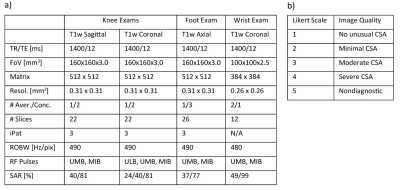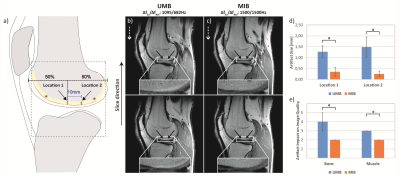Constantin von Deuster1,2, Stefan Sommer1,2, Christoph Germann3,4, Natalie Hinterholzer2, Robin M. Heidemann5, Reto Sutter3,4, and Daniel Nanz2,4
1Siemens Healthcare, Zurich, Switzerland, 2Swiss Center for Musculoskeletal Imaging (SCMI), Balgrist Campus, Zurich, Switzerland, 3Radiology, Balgrist University Hospital, Zurich, Switzerland, 4University of Zurich, Zurich, Switzerland, 5Siemens Healthcare, Erlangen, Germany
1Siemens Healthcare, Zurich, Switzerland, 2Swiss Center for Musculoskeletal Imaging (SCMI), Balgrist Campus, Zurich, Switzerland, 3Radiology, Balgrist University Hospital, Zurich, Switzerland, 4University of Zurich, Zurich, Switzerland, 5Siemens Healthcare, Erlangen, Germany
MSK Imaging at 7 T using Turbo-Spin-Echoes (TSE) suffers from severe through-slice
chemical-shift artifacts due to unmatched, low to moderate RF-Pulse bandwidths.
Increasing and matching RF-bandwidths to 1500 Hz for both pulse types allows reliable non-fat suppressed MSK imaging.

a) TSE Imaging parameters: TR/TE: Repetition/Echo
Time, FoV: Field of View, Resol: Spatial Resolution, Aver./Conc.:
Averages/Concatenations, iPat: Grappa Acceleration Factor, ROBW: Readout
Bandwidth, SAR: Specific Absorption Rate, b) evaluation criteria for
qualitative analysis of through-slice chemical-shift artifacts (CSA).

The chemical-shift artifact (*) width (green
double arrow) was measured at two locations (black arrows): (i) at 50 % condyle
height and (ii) separated by 10 mm along the posterior direction (a). b) Stronger
artifacts due to unmatched and moderate RF-bandwidths (UMB), compared to smaller
artifacts obtained with matched and increased RF-bandwidths (MIB) (c). The
phase encoding direction is along the head-feet direction (dashed white arrow).
d) Artifact size for both locations and UMB/MIB. e) Artifact rating for bone
and muscle tissues and UMB/MIB (*: significant difference).
